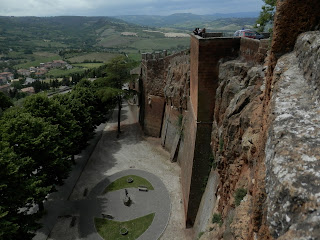I have been to a lot of Italy, but there is so much more to see. We took a daytrip up to Orvieto for a change of scenery. I had not stopped there before.
Located about half-way between Rome and Florence, it’s a town that sits on the top of an oval shaped volcanic plug, putting the main town about 200 m above the surrounding countryside. In that countryside, they make one of the best white wines in all of Italy. But the town itself is cool, having been a main city in Etruscan times, and having been around a long time before that. It was even the temporary home to the Pope for a while back in the 1500’s, since it was (in those days) readily defended from attack. Today, you can drive up, or take the funicular.
 |
| Passing lane ahead |
 |
| Okay, that's nice |
 |
| An ancient turret guards nothing |
 |
| I LOVE this castle |
 |
| Heck of a valley |
 |
| Ancient eagles watch over the countryside |
 |
| And what a countryside |
 |
| The gate they guard |
 |
| You can get to the city walls, but then what? |
 |
| Houses flow down the hillside |
 |
| The commanding view of below |
 |
| Another city gate |
 |
| Wow |
 |
| Them's stripes. Basalt & travertine |
 |
| Imposing |
 |
| Hmmn... |
 |
| Cain slaying Abel |
 |
| Dudes in heaven & purgatory |
 |
| A purgatory dude |
The rest of the town is quirky. There are narrow little streets, lined with houses made of basalt and tufa.
 |
| Elegant back streets |
 |
| Arches hold the buildings apart, not together |
 |
| A main road, with JUST enough space for one car |
 |
| Like Sienna, the city has sections with their own colours |
 |
| City hall |
 |
| Love parallax |
 |
| Ancient hitching posts, in basalt |
 |
| An ancient cave converted to an olive mill. Millstone visible |
 |
| An Etruscan well. See below |
 |
| A dovecot. Accessible from the outside, doves lived in the holes |
 |
| A channel to feed rain water underground for the doves |
 |
| My GOD! A GHOST!!! |
 |
| Caves leading to dovecots |
Being on the top of a volcanic plateau, getting water was a trick. About 60-100 m down is a clay layer with the water table. The Etruscans, and later others (including a Pope), dug wells WAY down to this water. One was discovered only a few years back in a dude’s basement:
 |
| VERY deep |
But the second well we explored (Pozzo de la San Pietro) was WAY cool. It was big. It too was deep (68 m down to the water). It was built by a Pope in the 1500’s. Mules were used to go down, get the water, and come back up, because it was so deep. So they could go down and come up it easily, they built a spiral ramp with 268 steps down and up in the shape of a double helix (concentric spirals). Basically a big one-way road down and up. Very, very cool bit of engineering.
 |
| The surface |
 |
| The endless stairs down |
 |
| WAY down there |
 |
| Half way down and still WAY down there |
 |
| Getting closer . The bridge and water now visible |
 |
| Looking back up |
Italy’s just full of these little towns, which is why I keep going back there.

No comments:
Post a Comment